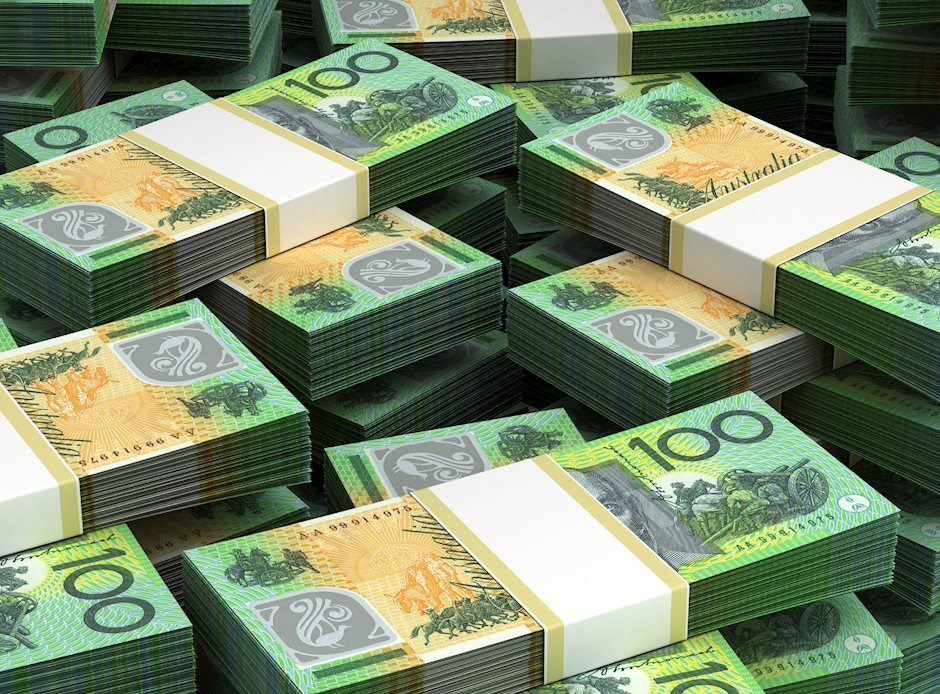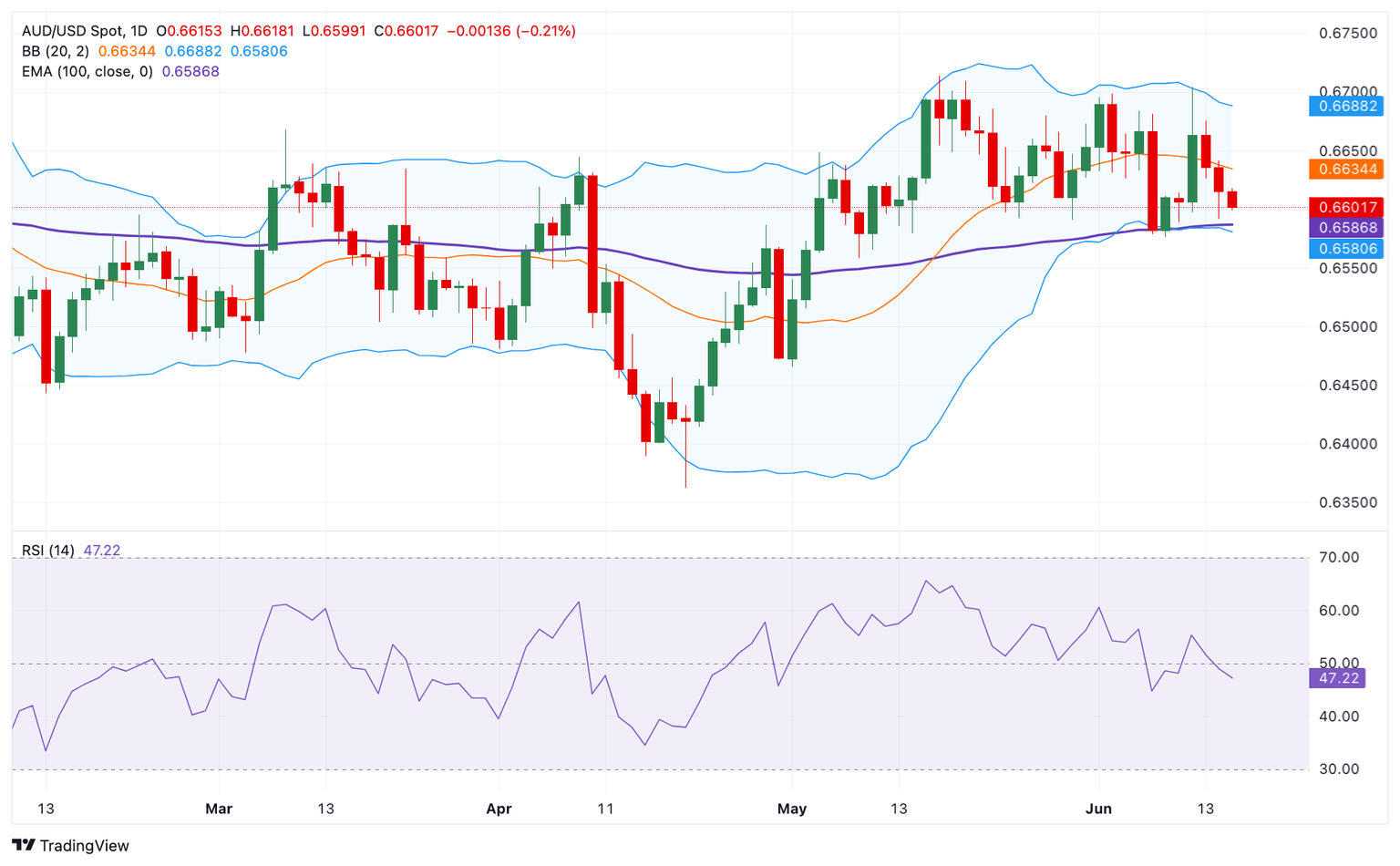Australian Dollar faces some selling pressure amid firmer US Dollar, mixed China’s economic data
- The Australian Dollar extends decline on the firmer US Dollar in Monday’s early European session.
- The hawkish tone of the Fed and challenges in China’s economic recovery weigh on AUD/USD.
- The RBA interest rate decision on Tuesday will be in the spotlight, with no change in rate expected.

The Australian Dollar (AUD) extends downside for the third consecutive day on Monday on the back of the stronger US Dollar (USD) broadly. The Greenback remains well-supported by the expectation that US interest rates will stay higher for longer, with the median projection from Federal Reserve (Fed) officials calling for one interest rate cut this year.
Furthermore, the latest mixed Chinese economic data and some challenges in China's economic operations might exert some selling pressure on the Aussie as China accounts for one-third of Australian exports. Investors will closely watch the Reserve Bank of Australia (RBA) interest rate decision on Tuesday, along with the Governor Michele Bullock press conference. The hawkish hold from the RBA could boost the AUD and cap the downside for AUD/USD in the near term. On the US docket, the Retail Sales for May will be released, which is expected to improve to 0.3% from 0% in April.
Daily Digest Market Movers: Australian Dollar attracts some sellers ahead of RBA policy meeting
- The Reserve Bank of Australia (RBA) will likely keep the cash rate at 4.35% for a fifth straight meeting as it tries to restrain consumer prices that have been underpinned by an ultra-tight employment market, economists surveyed by Bloomberg forecast.
- China’s Retail Sales improved 3.7% YoY in May from 2.3% in April, which is better than the estimate of 3.0%. Meanwhile, the nation’s Industrial Production rose 5.6% YoY in the same period, compared to the previous reading of 6.7%, below the consensus of 6.0%, the National Bureau of Statistics (NBS) showed Monday.
- The preliminary University of Michigan's Consumer Sentiment Index declined to 65.6 in June from 69.1, below the market consensus of 72.
- The UoM one-year Consumer Inflation Expectation held steady at 3.3%, while the five-year inflation outlook rose to 3.1% from 3%.
- Minneapolis Fed President Neel Kashkari said on Sunday that it is a “reasonable prediction” that the central bank will wait until December to cut interest rates. Kashkari added that the Fed is in a very good position to get more data before making any decisions.
- Cleveland Fed President Loretta Mester noted on Friday that she would like to see good-looking inflation data, adding that the path towards the Fed's 2.0% inflation goal may take longer than expected.
Technical Analysis: AUD/USD’s positive outlook remains fragile in the longer term
The Australian Dollar trades weaker on the day. The bullish outlook of the AUD/USD pair seems vulnerable as it hovers around the key 100-day Exponential Moving Average (EMA) on the daily chart. The pair could resume its downside journey if it crosses below the key EMA, as mentioned. Additionally, the 14-day Relative Strength Index (RSI) holds below the 50-midline, indicating that further downside cannot be ruled out for the time being.
The key support level for AUD/USD will emerge at the 0.6580-0.6585 region, portraying the confluence of the 100-day EMA and the lower limit of Bollinger Band. A decisive break below this level could see a drop to 0.6510, a low of March 22. The additional downside filter to watch is 0.6465, a low of May 1, and finally, the psychological level and a low of April 17 at 0.6400.
On the upside, the immediate resistance level is seen at 0.6688, the upper boundary of the Bollinger Band. Further north, the next upside target is located at 0.6715, a high of May 16. The next hurdle to watch is 0.6760, a high of January 4.
Australian Dollar price today
The table below shows the percentage change of Australian Dollar (AUD) against listed major currencies today. Australian Dollar was the weakest against the Japanese Yen.
| USD | EUR | GBP | CAD | AUD | JPY | NZD | CHF | |
| USD | 0.03% | 0.09% | 0.04% | 0.23% | -0.09% | 0.37% | 0.01% | |
| EUR | -0.03% | 0.05% | -0.01% | 0.18% | -0.11% | 0.33% | -0.05% | |
| GBP | -0.09% | -0.04% | -0.06% | 0.14% | -0.16% | 0.26% | -0.08% | |
| CAD | -0.04% | -0.01% | 0.04% | 0.20% | -0.10% | 0.33% | -0.03% | |
| AUD | -0.20% | -0.20% | -0.14% | -0.18% | -0.32% | 0.14% | -0.24% | |
| JPY | 0.07% | 0.08% | 0.18% | 0.14% | 0.29% | 0.48% | 0.07% | |
| NZD | -0.38% | -0.34% | -0.28% | -0.34% | -0.15% | -0.49% | -0.37% | |
| CHF | -0.01% | 0.03% | 0.08% | 0.03% | 0.22% | -0.10% | 0.36% |
The heat map shows percentage changes of major currencies against each other. The base currency is picked from the left column, while the quote currency is picked from the top row. For example, if you pick the Euro from the left column and move along the horizontal line to the Japanese Yen, the percentage change displayed in the box will represent EUR (base)/JPY (quote).
Australian Dollar FAQs
One of the most significant factors for the Australian Dollar (AUD) is the level of interest rates set by the Reserve Bank of Australia (RBA). Because Australia is a resource-rich country another key driver is the price of its biggest export, Iron Ore. The health of the Chinese economy, its largest trading partner, is a factor, as well as inflation in Australia, its growth rate and Trade Balance. Market sentiment – whether investors are taking on more risky assets (risk-on) or seeking safe-havens (risk-off) – is also a factor, with risk-on positive for AUD.
The Reserve Bank of Australia (RBA) influences the Australian Dollar (AUD) by setting the level of interest rates that Australian banks can lend to each other. This influences the level of interest rates in the economy as a whole. The main goal of the RBA is to maintain a stable inflation rate of 2-3% by adjusting interest rates up or down. Relatively high interest rates compared to other major central banks support the AUD, and the opposite for relatively low. The RBA can also use quantitative easing and tightening to influence credit conditions, with the former AUD-negative and the latter AUD-positive.
China is Australia’s largest trading partner so the health of the Chinese economy is a major influence on the value of the Australian Dollar (AUD). When the Chinese economy is doing well it purchases more raw materials, goods and services from Australia, lifting demand for the AUD, and pushing up its value. The opposite is the case when the Chinese economy is not growing as fast as expected. Positive or negative surprises in Chinese growth data, therefore, often have a direct impact on the Australian Dollar and its pairs.
Iron Ore is Australia’s largest export, accounting for $118 billion a year according to data from 2021, with China as its primary destination. The price of Iron Ore, therefore, can be a driver of the Australian Dollar. Generally, if the price of Iron Ore rises, AUD also goes up, as aggregate demand for the currency increases. The opposite is the case if the price of Iron Ore falls. Higher Iron Ore prices also tend to result in a greater likelihood of a positive Trade Balance for Australia, which is also positive of the AUD.
The Trade Balance, which is the difference between what a country earns from its exports versus what it pays for its imports, is another factor that can influence the value of the Australian Dollar. If Australia produces highly sought after exports, then its currency will gain in value purely from the surplus demand created from foreign buyers seeking to purchase its exports versus what it spends to purchase imports. Therefore, a positive net Trade Balance strengthens the AUD, with the opposite effect if the Trade Balance is negative.
Author

Lallalit Srijandorn
FXStreet
Lallalit Srijandorn is a Parisian at heart. She has lived in France since 2019 and now becomes a digital entrepreneur based in Paris and Bangkok.


















